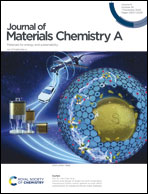Dual-defect surface engineering of bimetallic sulfide nanotubes towards flexible asymmetric solid-state supercapacitors†
Abstract
Nickel cobalt sulfide (NiCo2S4) is a promising battery-type material for electrochemical energy storage. However, the slow charge transfer kinetics and ion diffusion as well as the deficiency of electrochemically active sites hinder the practical application of NiCo2S4. Defect engineering at the atomic level is adopted to improve charge storage kinetics, through the incorporation of P dopants and S vacancies onto the surface of a NiCo2S4 nanotube (P-NiCo2S4−x). Experimental results reveal that the introduction of these defects effectively increases the electrical conductivity and induces the formation of low oxidation state Ni and Co species, accelerating the charge transfer kinetics and enabling rich faradaic redox chemistry. Moreover, the partial substitution of S sites with P improves the covalent nature of P-NiCo2S4−x, facilitating surface electroactivity. The as-prepared P-NiCo2S4−x shows a high specific capacity of 1806.4 C g−1 at 1 A g−1 and a 95.5% capacity retention after 5000 cycles at a high current density of 30 A g−1. Flexible solid-state asymmetric supercapacitors with P-NiCo2S4−x and activated carbon as the positive and negative electrodes, respectively, deliver a high energy density of 68.2 W h kg−1 at 800 W kg−1 and excellent cycling stability. Moreover, the device exhibits good mechanical flexibility with negligible capacitance decay under different bending states.



 Please wait while we load your content...
Please wait while we load your content...